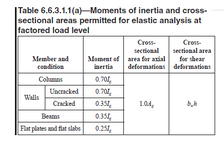It's tedious to make two models - one for serviceability and one for strength. If one model changes, the other will need to change as well. For large projects, this requires a lot of coordination and extra modeling. What I do is use the cracked model but with reduced wind for drift. The wind return period for serviceability is in the appendix of ASCE 7 and this can be handled with a combination. I personally use D+0.5L+0.42W. I don't remember how I got to this; it's documented in my extensive standards somewhere, but it's kind of a clue for you. I'm basically just scaling the load combination using V
serviceability2 / V
strength2.
Since I am using walls cracked by strength level forces, this approach is conservative. However, it can be adjusted by using lower level wind, and ASCE 7 gives a few different values you can use.
You mentioned that cracked section refers to seismic loads. This is not true. A wall does not care if it's hit with seismic or wind forces. Wind loads can cause cracking, whether it is strength or service level.
@ANE91 mentioned checking cracking by hand, and not relying on software. Well, we do need the software to run the load distribution in the first place. We can calculate seismic/wind loads at each level and do a distribution based on the center of rigidity, but we wouldn't be using the FEM software in the first place if we were doing that. I do agree that you should know what the software is doing, but there are massive speed benefits to using the software. I agree with people who say that we shouldn't rely on software for a lot of questions that come up, but this is too complicated to do by hand, and projects won't be profitable that way.
The way I check cracking in ETABS is comparing shell stresses to the modulus of rupture, as
@Agbsh mentioned. I always forget which thing to use; is it S22, S23, F22, or something else? The easy way to remember which one to use is to make a test model with only a wall and apply a lateral load of 10 kips or something. Do a hand calc of the tension/compression stress at ends, and compare it with the value you got by hand. Then you know which shell stress to use in ETABS. I find this method easier than learning what all the different stresses in ETABS are.


